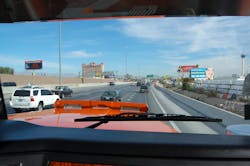PeopleNet to roll out new onboard Video Intelligence system
In the first quarter of 2015, PeopleNet will begin beta testing of a unique new onboard video camera system, called “Video Intelligence.” The system is designed to provide the driver with much more information about what is going on around the vehicle as well as provide the fleet with more information about the truck and the environment in which it is operating—think surveillance around the tractor and trailer, enhanced safety and better liability protection.
“Our motto is: ‘We are not watching the driver; we are watching out for the driver,’” Mike Nalepka, general manager Video Intelligence for PeopleNet, told Fleet Owner.
The new Video Intelligence system will include four separate video cameras: one forward facing, one on each side of the vehicle, and one rear-facing (either mounted at the back of a tractor (bobtail) or the back of a trailer, plus a digital video recorder.
The forward facing camera, which provides a 150-degree view in front of the vehicle, is constantly recording from the point the engine starts or the driver logs in. That recording is sent via cellular (3G/4G) or Wi-Fi to the PeopleNet Portal where it is combined with meta data from the PeopleNet system as a whole concerning the driver, Hours of Service, the tractor/trailer, the load, stops and so on. The forward-facing camera also captures video when an onboard event recorder is triggered by things like speeding, rapid stops or acceleration, swerving or lane departure.
The camera at the rear of the vehicle captures all backing events while giving the driver a view of the area behind the tractor or trailer on the in-cab display. This removes the “blind spot,” to help reduce backing accidents, improve safety and reduce all too common backing-related damage claims.
Side-mounted cameras provide a 150-degree view on the left and right sides of the vehicle, offering drivers better visibility by seeing the real-time view live on the in-cab display to help reduce accidents. Like the other cameras, what they see is also recorded, in this case all left- and right-side incidents, for liability protection and driver coaching. There is also the option to record all lane change events.
Together, the cameras in PeopleNet’s Video Intelligence system offer a virtually 360-degree view around the vehicle and each camera is surrounded with infrared lights. The digital video recorder that works with the cameras can record up to 14 hours per day and can go for about seven days before recording over older material
“There is a period of time when a customer can get access to all of the recordings,” Nalepka said. “This can be helpful if there is an incident and you want to see the circumstances that led up to the event, for instance, or if you are looking for patterns of behavior or trends.”
Videos will be accessible via the PeopleNet portal, which means fleets will have one source for telematics and video. A new tab for video will be a part of PeopleNet’s base offering, Nalepka noted. Users will be able to sort video by driver, event, tractor or trailer and severity of event. Sophisticated analytic tools will further divide videos into new videos, newly reviewed videos, videos that require attention and critical videos.
Because the system shares data with the company’s telematics, software and advanced analytics offerings, it is designed to deliver benefits that reach deep into the enterprise as a whole, expanding usefulness and multiplying ROI, according to PeopleNet. The list is long: from lowering liability and risk, to providing advanced analysis of driver performance for driver coaching; creating/managing of driver performance incentive programs to improving asset utilization; lowering equipment, fuel and cargo costs; and reducing freight claim costs.
Video Intelligence is yet another element in PeopleNet’s “ConnectedFleet Platform,” or what the company calls “The Internet of Transportation Things,” a trademarked name. In addition to the four cameras and digital video recorder unit, it includes a cab-forward antenna; mobile gateway to wirelessly connect drivers, equipment and devices—sending data to the cloud where it is dispensed with real-time speed; and various PeopleNet display devices, including the PeopleNet Display 4, PeopleNet TABLET and an Android-powered tablet.
“Our Internet of Transportation Things also includes our third-party providers,” chief technology officer, Mark Botticelli, explained. “Our system enables all onboard systems to communicate with one another, right on the vehicle instead of having to send all data to the back office first and then out again, as necessary.”
Video Intelligence is also an element of the company’s five-year plan and is a reflection of its core values beginning with: to “make transportation safer and more efficient through mobile technology”. “We want to create a ‘Safety Zone’ around the truck,” Brian McLaughlin, PeopleNet president, told Fleet Owner. “We are thinking in terms of ‘the new possible.’”
About the Author
Wendy Leavitt
Wendy Leavitt is a former FleetOwner editor who wrote for the publication from 1998 to 2021.
